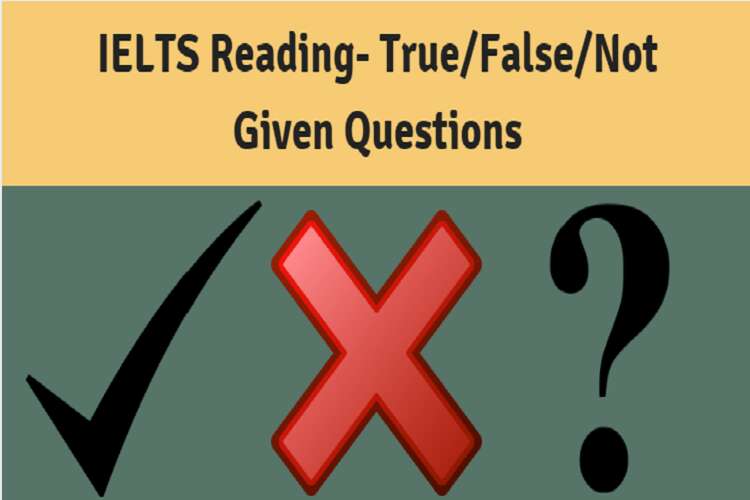IELTS reading tests have True/ False/ Not Given (T/ F/ NG) type questions, which may have 5 to 6 statements and the student is required to mark whether the statements are True; False or Not Given.
All the statements are related to the topic of the given passage. However, the statements in the question may not be direct. All statements need to be analysed only concerning the passage and answered only based on the given passage.
Below is an example question.
1. Example Question on True/ False/ Not Given Topic
Question 1:
Are the following statements true, false or not given according to the information given in the passage?
In boxes 1 to 5 in your answer sheet, write:
True – If the statement matches the information in the passage.
False – If the statement contradicts the information in the passage.
Not Given – If the information is not found in the passage.
The question can alternatively take this form.
Question 2:
Do the following statements agree with the information given in reading passage 2?
Answer True, False or Not given to questions 6 to 10.
|
True |
if the statement agrees with the information |
|
False |
if the statement contradicts the information |
|
Not given |
if there is no information on this |
2. Why Do Students Struggle with True/ False/ Not Given or Yes/ No/ Maybe Questions?
- Firstly people are often confused about the true meaning of these three terms.
- Secondly, these types of questions cannot be answered by directly spotting or matching keywords.
Let us understand this better.
True Meaning of True/ False/ Not Given
How to understand which of the following statements is true/ false or not given?
Whenever you have a sentence, you first ask “does the passage or author state this statement as a fact or opinion or reason?”
- If the answer is “yes” the statement is True.
- If your answer is “not a yes”, you must then ask another question for the same statement – “is this statement, against a fact or opinion or reason mentioned in the passage”. If your answer is “yes” then this statement is False.
- If your answer to question two is “no” then you must be very careful to ask the third question “no matter how true the statement seems, is this mentioned in the passage”? If the answer is “no”, then this is a Not Given case.
Also Read: Is IELTS Required for Canada? IELTS Band Guideline to Study in Canada
3. Example Essay With Questions
Let us take an example:
The first Britons (people who live in the United Kingdom) were the Picts, who arrived about 10,000 years ago. In the eighth century B.C., the Celts arrived from Europe and pushed the Picts north into Scotland. In A.D. 43, the Romans invaded and ruled for nearly 400 years. They built roads, bathhouses, sewers, and large villas.
By the sixth century A.D., German people known as Angles, Jutes, and Saxons were moving into Britain. The Angels gave their name to England, and English people became known as Anglo-Saxons. From the 900s to the 1400s, England was ruled by Viking, Danish, and Norman invaders. In 1485 the Welsh noble Henry Tudor claimed the English crown and became Henry VII, the first of five Tudor monarchs. Several important lines of kings and queens followed.
By the 1800s, Britain was one of the most powerful nations in the world. Trade generated immense wealth, and the country built a huge overseas empire. But the early 20th century was a time of setbacks for Britain. Drained by World War I and II, Britain could no longer afford its empire, and most of its colonies became independent.
Now, try and answer these questions.
Questions 1 to 5:
Do the following statements agree with the information given in the passage above?
Answer True, False or Not Given to questions 1 to 5.
- The Celts were preceded by the Picts in the United Kingdom.
- The Romans ruled for nearly half a millennium.
- The first of the Tudor monarchs came to power in the 15th century.
- Trade made Britain one of the most powerful nations in the world.
- Most of Britain’s colonies fought their war of independence during World Wars I & II.
View Answer
- T
- F
- T
- NG
- NG
Explanation On 1 to 5 Question Statements
Understanding each question statement given while comparing with the information and facts from the essay.
1. Let’s take the First Statement:
The Celts were preceded by the Picts in the United Kingdom.
View Answer
In this statement, it is important to understand the word ‘preceded’ as it holds the key to the answer. Also, this sentence cannot be directly spotted or matched with the words in the passage.
“Preceded” means to “come before something in time or order”. Take a re-look at the sentence with the meaning of “preceded” now. The statement means that “The Picts came before the Celts”.
In the given passage, look for information on Picts & Celts. You can find it in the first few lines of the first para- “The first Britons (people who live in the United Kingdom) were the Picts, who arrived about 10,000 years ago.
In the eighth century B.C., the Celts arrived from Europe and pushed the Picts north into Scotland”. These lines clearly say that the Picts came first and they were followed by the Celts, who pushed them to Scotland.
Now ask the question: “Does the passage or author state this statement as a fact or opinion or reason?”.
The answer is Yes, so the statement is True.
2. Now, Look at the Second Statement:
The Romans ruled for nearly half a millennium.
View Answer:
Again, in this statement, it is important to understand the word “millennium” as it holds the key to the answer. A “Millennium” means a period of a thousand years. So, half a millennium is 500 years. Given this meaning, the statement can be restated as “The Romans ruled for nearly 500 years”.
In the passage, look for information on Romans. We can find the lines, “In A.D. 43, the Romans invaded and ruled for nearly 400 years.” This line clearly states that the Romans ruled for 400 years (which is contradictory to what the statement says).
So, let’s ask the question “Does the passage or author state this statement as a fact or opinion or reason?”. The answer is clearly “Not a Yes”. In that case, you must then ask another question for the same statement – “Is this statement, against a fact or opinion or reason mentioned in the passage”. “Yes,” it is because in the passage he says that the Romans ruled for 400 years.
Then this statement is False.
3. Let’s Take up the Fourth Statement:
Trade made Britain one of the most powerful nations in the world.
View Answer
In the passage, look for information on trade. We can find it in the third paragraph of the passage, “By the 1800s, Britain was one of the most powerful nations in the world. Trade generated immense wealth, and the country built a huge overseas empire”.
These two lines talk about Britain becoming one of the most powerful nations and that it built huge overseas empires with the wealth that is generated out of its trade.
However, it does not state clearly that trade made Britain one of the most powerful nations.
Now let’s ask the question: “Does the passage or author state this statement as a fact or opinion or reason?”. The answer is clearly “Not a Yes”.
Ask the Second Question
In that case, you must then ask yourself the second question for the same statement – “Is this statement, against a fact or opinion or reason mentioned in the passage”. No, because the statement is not against any fact or opinion mentioned in the passage.
Ask the Third Question
Now you must be very careful to ask the third question “No matter how true the statement seems, is this mentioned in the passage”? Now, if we look at the passage, a relationship between trade & Britain’s power in the world is not mentioned anywhere.
So, the answer to the third question is “NO”. It is thus a Not Given case.
4. Confusion Between Three Options – T/ F/ NG
So it is clearly understood that answering an essay question is not a simple task but we could make it easier by removing confusion between the options. We will be discussing the confusion between the below cases:
- False and Not Given
- True and Not Given
- True and False
The Confusion between False and Not Given.
So statement 5 is a question which can confuse students between false and not given options and we have explained below which option is precise.
Let us look at this statement: Most of Britain’s colonies fought their war of independence during World Wars I & II.
- This statement seems false on a general level. You might want to mark it False already.
- But you should really start with the three questions to identify the answer.
- So, first, ask “Does the passage or author state this statement as a fact or opinion or reason?”. Look at the last line of the passage: “Drained by World War I and II, Britain could no longer afford its empire, and most of its colonies became independent”.
This line means that Britain lost a lot of wealth in the two world wars. After the two wars, Britain did not have enough wealth left to afford its empires and soon after most of its colonies became independent nations.
So, clearly, the answer to the first question is “Not a Yes” since the author has not stated this anywhere in the passage.
More Detailed Analysis
Now, how do we judge if the statement complies to the question for False? Let us see. The first question was: “Does the passage or author state this statement as a fact or opinion or reason?”.
The given statement does not go against any information or fact or opinion from the passage. In fact, it says things which are not mentioned in the passage. So, the statement cannot be termed as “False”. Hence we need to see Not Given as an option.
More Detailed Analysis
You must then ask the second question for the same statement – “Is this statement, against a fact or opinion or reason mentioned in the passage”. Now, there is nothing in the passage that clearly is against this statement i.e., there is no line in the passage that says that the colonies did not fight for their war of independence during World Wars I & II. It does not clearly say so anywhere, so the answer to the second question is “No”.
Now you must be very careful to ask the third question “No matter how true the statement seems, is this mentioned in the passage”? Relook at the line again, does the line mention that the colonies fought for their independence during the world wars? The answer is “No”, so this is a Not Given case.
Also Read: How to get an 8.5 score band in the IELTS
The Confusion between True and Not Given?
Let us look at this statement 4 again: Trade made Britain one of the most powerful nations in the world. Now, this statement seems true and you may have previous knowledge to lead you to believe it is true.
But concerning the passage, what is your answer to the question: “Does the passage or author state this statement as a fact or opinion or reason?”. Again, relook at the sentence on trade in the last part of the passage. The given statement is not mentioned anywhere in the passage, so the answer to question one is “No”.
More Detailed Analysis
Next, ask yourself the second question for the same statement – “Is this statement, against a fact or opinion or reason mentioned in the passage”. Relooking at the passage, we find that the passage does not say anywhere that trade did not make Britain one of the most powerful nations. So, the answer to question two is “No”.
Now ask yourself the third question: “No matter how true the statement seems, is this mentioned in the passage”? Does the author mention this relationship between trade & Britain’s power anywhere in the passage? No, it is not mentioned anywhere in the passage, although we may think from our previous knowledge that this may have been true. So the answer to this statement is “Not Given”.
The Confusion between True and False?
Let us look at this statement: The first of the Tudor monarchs came to power in the 15th century.
From the passage, the first search for information on Tudor monarchs. We can find this information in the second part of the passage: “In 1485 the Welsh noble Henry Tudor claimed the English crown and became Henry VII, the first of five Tudor monarchs”.
The year 1485 is important here as the statement mentions the century whereas the passage mentions the year. Do make a note of this. So our gut feeling may be to discard the sentence as FALSE thinking 1458 is the 14th century. Actually the 1400s is considered as the 15th century.
More Detailed Analysis
So the sentence in the passage can be understood as “In the 15th century, Henry VII became the first Tudor monarch to come to power” Thus, dates and years are important to note and analyse concerning the given statement. So, no matter how irrelevant the statement seems, never discard it as a False statement based on your gut feeling or general knowledge.
Now if we ask the first question, “Does the passage or author state this statement as a fact or opinion or reason?”. The answer to the statement is actually True, as the passage mentions it as a fact in the second part.
5. The Last Part
Never jump the gun in a T/ F/ NG type question no matter what it seems at the outset.
Stick to the questions and you will never go wrong.
Follow the “Mantra of Three”
- “Does the passage or author state this statement as a fact or opinion or reason?” If the answer is “Yes” the statement is True.
- If your answer is “Not a Yes”, then ask – “Is this statement, against a fact or opinion or reason mentioned in the passage”. If your answer is “Yes” then this statement is False.
- Now ask the third question “No matter how true the statement seems, is this mentioned in the passage”? If the answer is “NO”, then this is a Not Given case.
6. How to Find Answers for T/ F/ NG in the Passages?
Let us look at this statement question. Trade made Britain one of the most powerful nations in the world.
Now the first task is to find out, which paragraph, talks about this fact. If you have annotated (meaning marked or made notes) your passage, you must look at the underlined parts which will help you locate the information easily.
Once the paragraph is located, comes the more tricky part. T/F/NG are not fact or feature-based statements, hence you need to understand the paragraph.
Let Us See How:
The first Britons (people who live in the United Kingdom) were the Picts, who arrived about 10,000 years ago. In the eighth century B.C., the Celts arrived from Europe and pushed the Picts north into Scotland. In A.D. 43, the Romans invaded and ruled for nearly 400 years. They built roads, bathhouses, sewers, and large villas.
In this paragraph, the author essentially tells about the history of the early settlers in the UK. He notes that the Picts came first, followed by the Celts, who then pushed the Picts to Scotland. Then in 1st AD (note A.D. 43 is 1st century A.D.), the Romans invaded the UK and ruled for about 400 years.
- Now look at the statement: The Celts were preceded by the Picts in the United Kingdom. It has the words Celts and Picts from the para but if you have not understood the word “preceded, you may misunderstand the statement completely. It is thus important to try and understand the meanings of words while reading the passage.
7. Consolidated Strategy
Thus to solve a T/ F/ NG types of questions, this is the consolidated strategy:
- Use annotation technique (i.e. mark or add notes) to single out the paragraph which talks about the said statement. Make sure you mark terms, numbers & figures in the passage when reading it in detail.
- Evaluate the statement with the “Mantra of Three”.
- Mark the answer as per the questions.
- Never make the mistake of assuming the statement to be true or false based on your general knowledge or gut feeling and base it only on what has been written in the passage.
Conclusion
Hope this comprehensive article makes you understand this type of question better. Let us know your thoughts on these types of questions, by commenting in the box below.









Very useful .exclusive explanation
Mam plzzz do send all other important parts of reading section of academic ielts…thankyou once again.
Can you check the answer to the first question?
The Celts were preceded by the Picts in the United Kingdom.
According to paragraph Picts came first and they were followed by the Celts
True and False questions are some of the difficult questions, thank you for giving me a proper strategy on answering the questions.
Thank you for poviding the tips for true and false questions, can you also provide a strategy for the other type of questions